Predators are animals feeding or preying on other
animals. The most common predators in sweetpotato field are those in
association with aphids like the ladybird beetles, syrphid flies and
lacewings. General feeders like mantids, spiders, earwigs, wasps and
predatory pentatomids are frequently seen attacking caterpillar pests. Species of ants and earwigs attack the
larvae of
sweetpotato weevil. Predatory mites, staphyplinids and coccinellids help
check the population build up of false spider mite and red spider mite.
Common Predators
Ladybird beetles
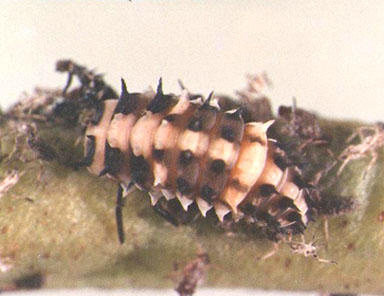 |
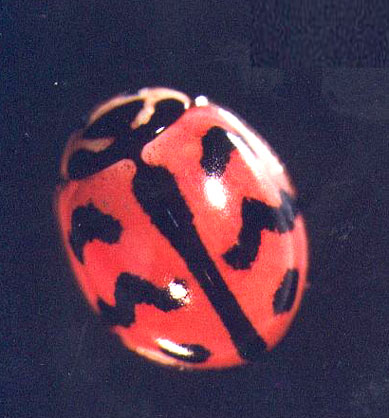 |
| larva (E.
Vasquez) |
adult (E. Vasquez) |
| M.
sexmaculatus |
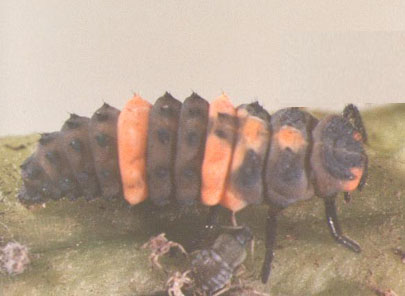 |
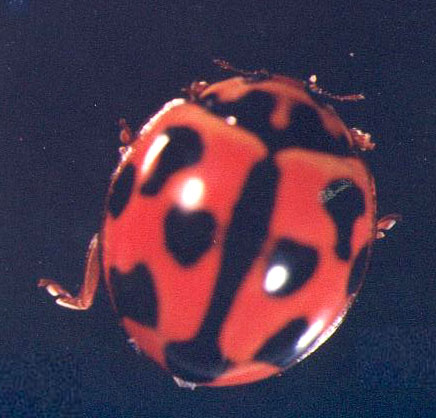 |
| larva (E. Vasquez) |
adult (E. Vasquez) |
| C.
inequalis |
Description
Adults are
hemispherical-shaped beetles, typically coloured red or orange with black spots.
Several species exist with variable spotting. Adults are usually 4- 6 mm. Larvae
are elongate flattened grubs. Adults and larvae are actively moving around the
plant and often live in aphid colonies. Adults are often confused with ladybugs
such as chrysomellid beetles.
Prey
Adults and larvae
feed on aphids and other small insects.
Syrphid
flies
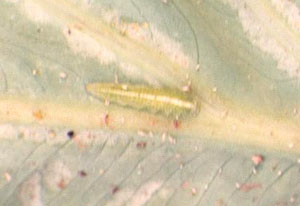 |
 |
| larva (E.
Vasquez) |
adult (E. Vasquez) |
|
Ischiodon scutellaris
|
Description
Adults
are attractive black and yellow flies which resemble bees.
They can easily be distinguished from bees since flies only
have two wings and bees have four. They commonly hover around
flowers. These flies do not sting or bite. Size ranges 14-19
mm. Larvae are green maggots found on leaf surfaces where
aphid colonies are found.
Prey
Larvae
feed on aphids. Adults feed on nectar from flowers and aid
in pollination in the process.
|
Lacewings
|
|
|
|
|
egg (CIP)
|
nymph (CIP)
|
adult (CIP)
|
Description
Adults have four glossy net-like wings folded like a tent
over the body. Larvae are called aphislions, generally elongate,
flattened and wider at the middle with large hooked mandibles
for catching and consuming prey. Small white eggs are laid
on stalks.
Prey
Adults
and larvae feed on aphids and other small-soft bodied insects.
|
Predatory
earwigs
|
|
|
Earwig
is a predator of
sweetpotato weevil (E. Vasquez).
|
Description
Any of various insects of the order Dermaptera. They vary
in size from 1- 2.5 cm length and brown to black in colour.
They may be winged or wingless with a few species as good
fliers. They have an elongate body that terminates in a pair
of pincer-like appendages or forceps, their most distinctive
characteristic, protruding from the rear of the abdomen. These
forceps are used in capturing prey and mating.
Earwigs hide in the soil or plant parts preferring moist
shady places during the day and become active during the night
when they look for eggs, larvae or nymphs of smaller insects
to prey on.
Prey
Earwigs feed on sweetpotato weevil larvae and other smaller
soft-bodied insects.
|
Mantids
Description
Adults have elongate, stick-like body with long legs. Front legs are enlarged
and come together to hold prey. The body is usually green but may be brown.
Adults have wings which are normally folded over the abdomen. All stages are
difficult to see in the field because they blend with their surroundings. Size
reaches up to 8-10 cm.
Prey
Mantids feed on a
variety of insects including grasshoppers, caterpillars, flies and bees. While
the mantid chews on the prey, it holds it with his forelegs. Prey is captured by
a rapid thrust as it moves by. The mantids hunt by waiting or very slow
stalking.
Spiders
|
|
|
|
lynx spider (E.
Vasquez).
|
crab spider (D.
Amalin).
|
Description
Spiders are eight legged creatures with two body regions,
characteristics that distinguish them from insects. Almost
all spiders form some webbings that help in catching their
preys and as defense against other predators.
Prey
All
spiders are general predators. They feed on several small
insect species. Many are quite effective at reducing pest
population.
|
Predatory
bugs (pentatomid and assassin bugs)
 |
|
pentatomid
bug
(E.
Vasquez)
|
Description
The
predatory pentatomid, shield or stink bugs, have well-developed
5-segmented antennae and characteristically
shield-like shape with well developed triangular scutellum
(part on the top-side of the thorax).
Assassin bugs have slender body, long legs, a long
narrow head, and an extended, 3-segmented, needle-like beak.
They are often brightly coloured and may often be blackish,
reddish, or brown.
Prey
Caterpillars
and probably other insects are attacked. Body fluids are extracted
from the prey by sucking.
|
Predatory ants
|
|
|
|
P.
megacephala
(H.
van den Berg).
|
big headed ants
(B. Kusuma).
|
Description
The big headed ant, Pheidole megacephala (Fabricius)
have a relatively large head compared to their bodies. Two
sizes (major and minor) of workers will be found in a colony.
They have 12-segmented antennae with a three-segmented club.
Prey
Eggs of sweetpotato weevil and other insects.
|
|
|
|
|
eggs
|
adults
|
|
Amblyseius
longispinosus (E. Vasquez).
|
Description
Mites are more closely related to spiders than they are to
insects. They do not have antennae like insects do, nor segmented
bodies nor wings. They are usually very small and often go
unnoticed. Most mites have an egg stage, a six-legged larval
stage, and two eight-legged stages before becoming an adult.
Phytoseiid mites are the major group of natural enemies that
attack certain kinds of pest spider mites.
Most predaceous mites are somewhat pear-shaped
and shiny, with noticeably long legs. They may be bright red,
yellow, or green depending on what they eat or may appear
transparent. Predaceous mite eggs are usually oblong instead
of spherical like the eggs of pest mite species. Predaceous
mites are also much more active and mobile than pest mite
species.
Prey
Red
spider mites, false spider mites and other phytophagous mite
species.
|
References
Dole, U. 1991. Beneficial insects of British Columbia cranberry bogs. http://www.direct.ca/pestpage/ben3.html.
28 September 2002.
Shepard, B.M., G.R. Carner, A.T. Barrion, P.A.C. Ooi and H. van den Berg.
1999. Insects and their Natural Enemies Associated with Vegetables and Soybean
in Southeast Asia. Quality Pronting Co. SC. USA. 108 pp.
Amalin, D.M. and E.A. Vasquez. 1993. A Handbook on Philippine Sweet Potato
Arthropod Pests and their Natural Enemies. International Potato Center, Los
Baņos, Laguna, Philippines. 82 pp.
Bajwa, W. I. 2001. Insect-pathogenic bacteria. http://www.ippc.orst.edu/biocontrol/biopesticides/papers/bacteria-ent-pathogens.html
Integrated Plant Protection Center (IPPC) Oregon State University, Corvallis. 26
September, 2002.
Contributed
by: Erlinda
Vasquez and
Vilma
Amante
|
Ladybird beetles
Syrphid flies
Lacewings
Earwigs
Mantids
Spiders
Predatory bugs
Predatory ants
Predatory mites
Parasitoids
Pathogens
Insect and mite pests
Insect pest image
gallery |

